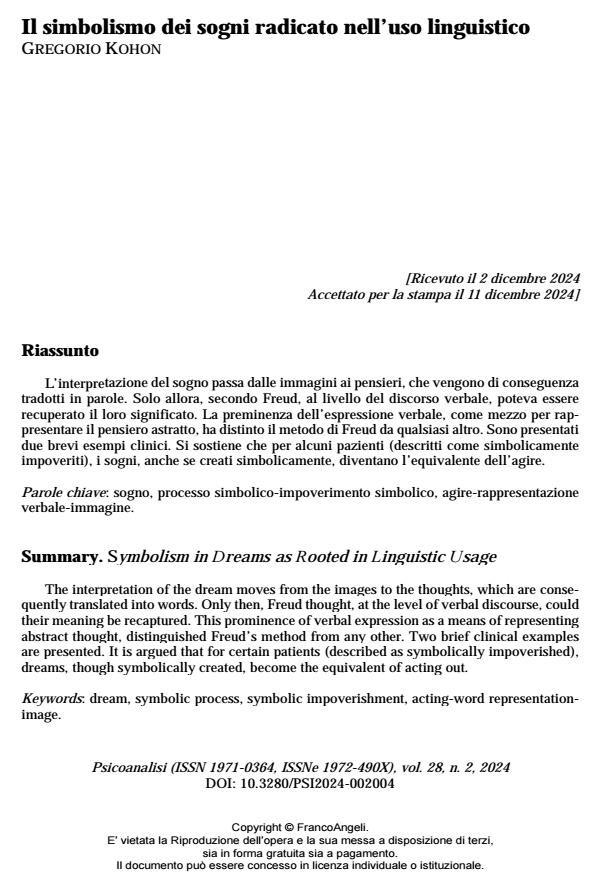Il simbolismo dei sogni radicato nell’uso linguistico
Titolo Rivista PSICOANALISI
Autori/Curatori Gregorio Kohon
Anno di pubblicazione 2025 Fascicolo 2024/2
Lingua Italiano Numero pagine 12 P. 49-60 Dimensione file 88 KB
DOI 10.3280/PSI2024-002004
Il DOI è il codice a barre della proprietà intellettuale: per saperne di più
clicca qui
Qui sotto puoi vedere in anteprima la prima pagina di questo articolo.
Se questo articolo ti interessa, lo puoi acquistare (e scaricare in formato pdf) seguendo le facili indicazioni per acquistare il download credit. Acquista Download Credits per scaricare questo Articolo in formato PDF

FrancoAngeli è membro della Publishers International Linking Association, Inc (PILA)associazione indipendente e non profit per facilitare (attraverso i servizi tecnologici implementati da CrossRef.org) l’accesso degli studiosi ai contenuti digitali nelle pubblicazioni professionali e scientifiche
L’interpretazione del sogno passa dalle immagini ai pensieri, che vengono di conseguenza tradotti in parole. Solo allora, secondo Freud, al livello del discorso verbale, poteva essere recuperato il loro significato. La preminenza dell’espressione verbale, come mezzo per rappresentare il pensiero astratto, ha distinto il metodo di Freud da qualsiasi altro. Sono presentati due brevi esempi clinici. Si sostiene che per alcuni pazienti (descritti come simbolicamente impoveriti), i sogni, anche se creati simbolicamente, diventano l’equivalente dell’agire. Parole chiave: sogno, processo simbolico-impoverimento simbolico, agire-rappresentazione verbale-immagine.
Parole chiave:sogno, processo simbolico-impoverimento simbolico, agire-rappresentazione verbale-immagine.
- Epson W. (1930). Seven Types of Ambiguity. Cambridge, Mass: New Directions, 1966. (trad. it. Sette tipi di ambiguità. Torino: Einaudi, 1968).
- Forrester J. (1980). Language and the Origins of Psychoanalysis. London: MacMillan
- Freud S. (1900). The Interpretation of Dreams. S.E. 4/5 (trad. it.: L’interpretazione dei sogni. In: OSF, vol. 3. Torino, Boringhieri, 1972).
- Freud S. (1913). The Claims of Psycho-Analysis to Scientific Interest. S.E. 13 (trad. it: L’interesse per la psicoanalisi. In: OSF, vol. 7. Torino, Boringhieri, 1972).
- Freud S. (1915-1916). Introductory Lectures on Psycho-Analysis (Parts I and II). S. E. 15. (trad. it: Introduzione alla psicoanalisi (1916-17). In: OSF, vol. 8. Torino: Boringhieri, 1972).
- Frost R. (1916). Out, Out. First published in McClure’s magazine. Later included in Mountain Interval. New York: H. Holt & Co. (1916/1921).
- Grinberg L. (1968). On Acting out and its Role in the Psychoanalytic Process. International Journal of Psychoanalysis 49, 1: 71-178.
- Klein M. (1952). Notes on some schizoid mechanisms. Int. J. Psycho-Anal., 27: 99-110. Also in M. Klein, P. Heimann; S. Isaacs, and J. Riviere. Developments in Psycho-analysis. London: Hogarth Press, 1952.
- Kohon G. (2000). Dreams, symbolic impoverishment and the question of the other. In Perelberg R., Dreaming and Thinking. Psychoanalytic Ideas, 4: London: The Institute of Psychoanalysis.
- Lacan J. (2010). The instance of the letter in the unconscious, or reason since Freud. Singapore: Wiley-Blackwell, 1957, pp. 432-448.
- McGuire W. (1974). The Correspondence between Sigmund Freud and C. G. Jung. (Trans. by Ralph Manheim and R.F.C. Hull). Cambridge Mass: Harvard University Press, 1988. Pontalis J. B. (1977). Frontiers in psychoanalysis: between the dream and psychic pain. (Trans. by Catherine Cullen and Philip Cullen; with an introduction by M. Masud R. Khan). London: Hogarth Press, 1981.
- Rosenfeld H. (1964). On the Psychopathology of Narcissism a Clinical Approach. International Journal of Psychoanalysis, 45: 332-337. DOI: 10.4324/9780429479335-1
- Sharpe E.F. (1937). Dream Analysis: A Practical Handbook for Psycho-Analysts. London: The Hogarth Press.
- Steiner J. (1993). Psychic Retreats Pathological Organizations in Psychotic, Neurotic and Borderline Patients. London & New York: Routledge.
- Thomas D. (1952). In Country Sleep, And Other Poems. London: Dent, 1952.
Gregorio Kohon, Il simbolismo dei sogni radicato nell’uso linguistico in "PSICOANALISI" 2/2024, pp 49-60, DOI: 10.3280/PSI2024-002004